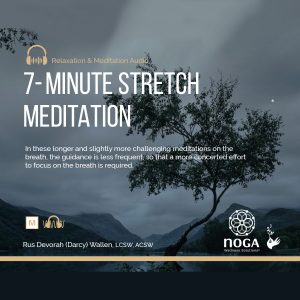The Meditative “Muscle and Motion” of the Mind
Last time I shared a little bit about how I include meditation in my therapy practice. In this installment, I would like to explain some of the concepts to help you better understand the mechanism of how meditation can help us become more present, focused, and calm.
I recommend that my clients do their meditation practice sometime earlier in the day, rather than at nighttime. Why? Since as you may recall, in the “THREE-LEGGED STOOL” approach, in the practice for the mind, we use a meditation. In it, we’re training the mind to settle and gain the capacity to choose what it pays attention to. William James said, “The greatest weapon against stress is our ability to choose one thought over another.” This is something that requires attention and practice. I think it’s advisable to meditate earlier in the day, since later, when we’re tired and have “used up” your energy budget, you don’t really have the ability to pay attention! Being able shift off of a daydream or mental “hijacking” and on to another subject is a skill that is developed over time and is easier when we’re more alert. When we’re meditating, each time we “choose” to focus on the breath, we strengthen the “meditative muscle.” This repeated practice “in the background” causes the neuroplastic effect, generalizing to our ability to stay present in day-to-day situations. The very act of repeatedly practicing paying attention gives us the skill for “real life.” I compare this to the pianist who in the practice room is practicing simple scales. When a friend enters and exclaims, “That’s not Mozart! What is that? That’s not music!” The musician can explain that by practicing these rudimentary scales, when she is on stage, her fingers will be able to fluidly flow over the keys while playing a Mozart or Rachmaninov concerto.
Similarly, during the “THE BEGINNER’S MEDITATION ON THE BREATH,” every time you come back to your breath (which is the object of the focus of this meditation), you are strengthening that neuronal connection so that it becomes second nature to pay attention to it. In this particular meditation the focus is on the breath, but just about any sensation or object of focus will do. You could use a sound of a bird, a flame, a color, etc. I find, however, using the breath as the focus is practical on many levels. Especially important is that the breath is handy, coming with us wherever we go. So, even if you don’t have a recording, or digital device, the breath is available. So, when you are meditating, every time your mind wanders to the birds, to the airplane, to the noise, or to extraneous thoughts like, “What am I going to have for dinner tonight?” You will catch yourself and say, “Oh, back to breath.” “I wonder how late the store is open.” Back to breath, etc. This is really the main effort of a “focal point” or “focus” meditation. When your mind wanders, bring it back to the object of focus. According to William James, one of the foundational theorists in psychology, believed the capacity for paying attention is one of the most important skills we need to develop. Here is what he said about it:
But, whether the attention come by grace of genius or by dint of will, the longer one does attend to a topic the more mastery of it one has. And the faculty of voluntarily bringing back a wandering attention, over and over again, is the very root of judgment, character, and will. No one is compos sui if he have it not. An education which should improve this faculty would be the education par excellence.
To help you develop your “Meditative Muscle,” enjoy our free downloads!
INTRODUCTION TO THE BEGINNER’S MEDITATION ON THE BREATH (always free)
THE BEGINNER’S MEDITATION ON THE BREATH (always free)
THE SEVEN MINUTE STRETCH MEDITATION (available until May 30th)
OCEAN: 5-MINUTE EXPANDING & CONTRACTING FOCUS MEDITATION (available until May 30th)
With Gratitude,
Rus Devorah



